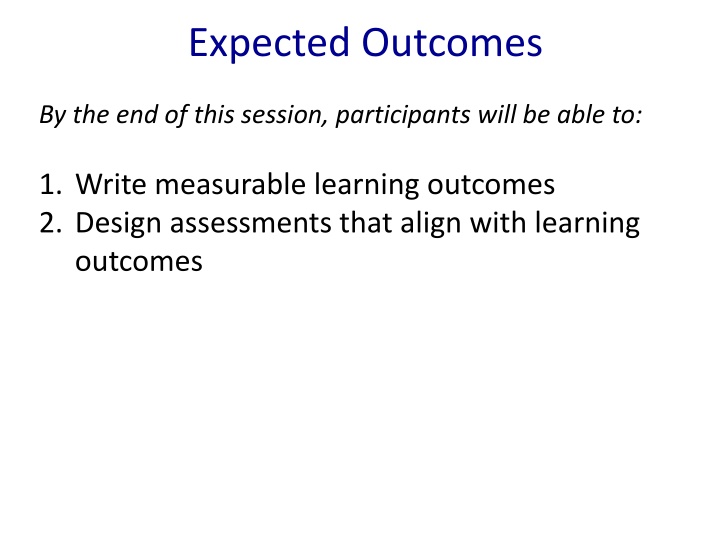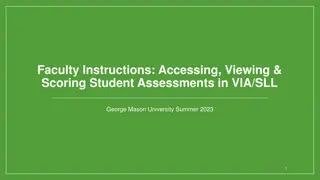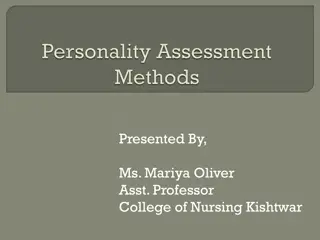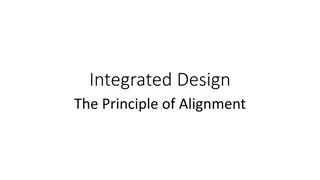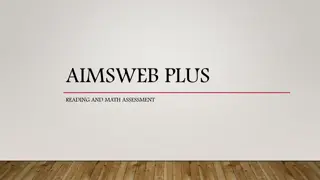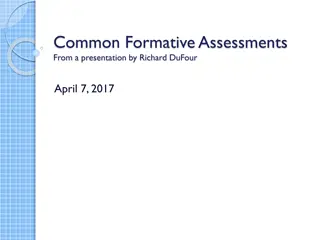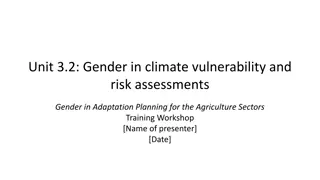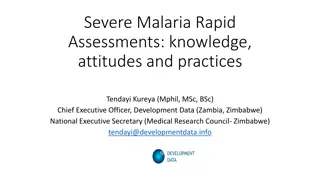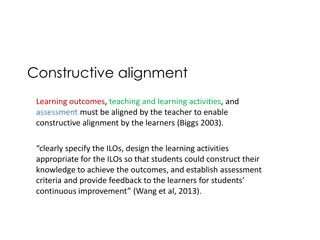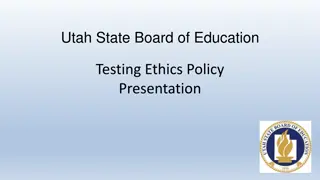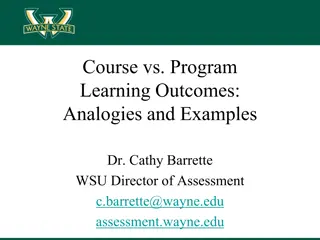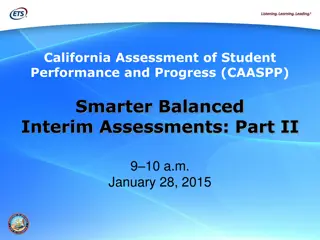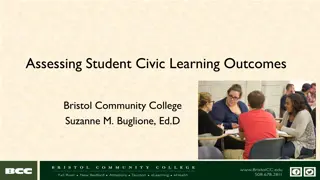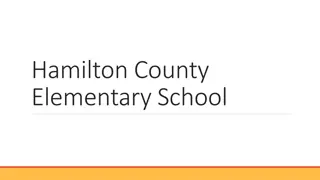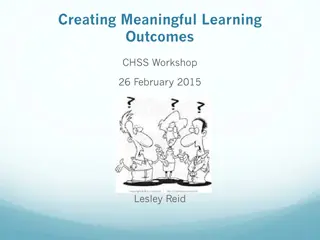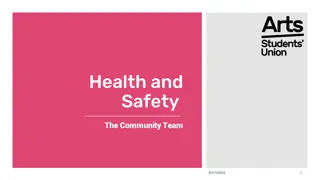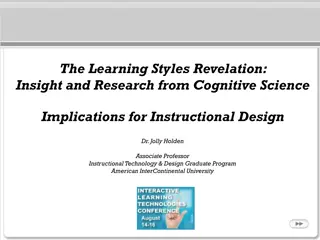Effective Design of Learning Outcomes and Assessments
This session covers writing measurable learning outcomes, designing assessments aligning with outcomes, creating assessments for specific outcomes, analyzing assessments to determine intended learning outcomes, and the importance of clarifying expectations for students and instructors through learning outcomes. Participants engage in practical exercises using Bloom's Taxonomy to enhance their understanding and application of these concepts.
Download Presentation

Please find below an Image/Link to download the presentation.
The content on the website is provided AS IS for your information and personal use only. It may not be sold, licensed, or shared on other websites without obtaining consent from the author.If you encounter any issues during the download, it is possible that the publisher has removed the file from their server.
You are allowed to download the files provided on this website for personal or commercial use, subject to the condition that they are used lawfully. All files are the property of their respective owners.
The content on the website is provided AS IS for your information and personal use only. It may not be sold, licensed, or shared on other websites without obtaining consent from the author.
E N D
Presentation Transcript
Expected Outcomes By the end of this session, participants will be able to: 1. Write measurable learning outcomes 2. Design assessments that align with learning outcomes
Warmup 1: Outcome-to-Assessment Write an assessment for the following learning outcome: Students will be able to compare and contrast the atmospheres of Venus, Earth, and Mars How could you tell if your students are able to do this? What would you ask them to do to demonstrate their ability? This could be any type of assessment, from very simple to quite involved.
Warmup 2: Assessment-to-Outcome Here s an example assessment. What do you think the instructor wanted students to be able to do? What was the learning outcome? The figure below shows a map of atmospheric pressure for somewhere in the NORTHERN HEMISPHERE. The labeled lines are isobars (lines of equal pressure). Assuming that the airflow here is GEOSTROPHIC,* what direction will the winds blow? *Geostrophic means that the Coriolis force balances the horizontal pressure gradient force
Why write learning outcomes? Clarify your expectations for students. Communicate what students will be able to do as a result of learning opportunities Help students focus their efforts on what s important Clarify your expectations for yourself. Guide your course design (assessments, activities) Focus instruction on what you think is important Help communicate with other faculty about your course Help define cohesive departmental curriculum
Intro to Blooms Taxonomy (useful tool) Anderson and Krathwohl, 2001
Practice w/ Blooms Taxonomy A course about The Three Little Pigs: A wolf looking for food finds three pigs, each one having their own home made of straw, sticks and finally, bricks. The wolf knocks on each door, threatening to blow their house down. The pigs with the straw and sticks fall victim to the wolf s threat. The homeless pigs take refuge in the third pig s house and the wolf is not able to blow the brick house down. The wolf comes down the chimney, and is caught in a pot of boiling water placed there by the third little pig. Credit: Jenny Knight & Stephanie Chasteen
Practice w/ Blooms Taxonomy Rate the cognitive level of these learning outcomes: 1. Compare and contrast the motivations of the wolf and the pigs 2. Predict which of the three pigs would rate highest on an IQ test (if you had been able to give it at the beginning of the story). 3. Describe the main characters in the story, and their roles. 4. Justify why the third little pig should not be prosecuted for boiling the wolf. Credit: Jenny Knight & Stephanie Chasteen
Clicker: What Blooms level did you rate: Describe the main characters in the story, and their roles. A. Remembering B. Understanding C. Applying D. Analyzing E. Evaluating
Clicker: What Blooms level did you rate: Predict which of the three pigs would rate highest on an IQ test (if you had been able to give it at the beginning of the story). A. Remembering B. Understanding C. Applying D. Analyzing E. Evaluating
Activity: Write Learning Outcomes For your context That align with your enduring concepts and larger- scale goals Write two outcomes that you think are at different Bloom s levels. Then Swap with another participant Independently, categorize each others outcomes by Bloom s level Discuss
Checklist for Learning Outcomes Does the learning outcome identify what students will be able to do after the learning experience? Is it clear how you would measure achievement of the learning outcome? Do chosen verbs have a clear meaning? Is the level of cognitive understanding appropriate? Is it aligned with your actual expectations and with student ability? Do your outcomes cover a range of levels? Is the terminology familiar/common? If not, is knowing the terminology a goal? Is the outcome relevant and useful to students (e.g. connected to their everyday life, or does it represent a useful application of the ideas)? Does the outcome align with your course-scale goals?
Example Learning Outcome? ... Bloom s level? A. B. C. D. E.
Activity: Assessment Types Stakes? Low High Formative? Summative? What will students do? Make a choice? Generate something? Write? Draw? Speak? Examples (handout)
Activity: Assessment Types Pair up with someone in a similar content area Trade 1-2 learning outcomes (previously written) Individually, write down ways your partner could assess his/her learning outcome (brainstorm) Discuss with your partner Debrief with large group
Activity: Write Assessments For your context That align with learning outcomes That align with the Bloom s level you expect
Reflection & Planning What do you plan to do in order to align your learning outcomes with your assessments in your course? What do you see as your main challenges in achieving alignment of learning outcomes and assessments in your course?
